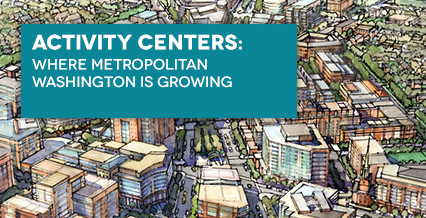
Washington, D.C. – The Metropolitan Washington Council of Governments (COG) voted unanimously today to approve an updated set of Activity Centers for metropolitan Washington. The centers will be used by COG and local governments to support land use planning, help guide investments in infrastructure and development, and analyze growth.
The Centers are diverse in size and form; they include existing urban centers, traditional towns, transit hubs, as well as areas expecting future growth. For example, Georgetown and downtown Manassas are vibrant, walkable places already built- out with a strong mix of housing and businesses. At the same time, Activity Centers such as NoMa, Clarendon, downtown Frederick, and Silver Spring are expected to experience major population and employment growth over the next several decades. (Click link for full map and fact sheet)
While the Centers vary in scale and type, the basic concept behind them is the same: concentrated development in areas that will have the planning and infrastructure in place to support it. By focusing growth in Activity Centers, the region will improve connections between housing and jobs, reduce environmental impact, and make better use of limited funds. The Centers will also promote development around area transit such as Silver Line Metro stations in Northern Virginia and Green Line Metro stations in Prince George’s County, Maryland. About two-thirds of Centers are or will be served by the region’s rail transit network of Metrorail, commuter rail and light rail.
The goal for this latest update was to make the Centers more broadly useful. To do so, more targeted and specific criteria were used to designate Centers. The new criteria are primarily based on targets in COG’s Region Forward vision and the Centers were vetted by local government planning departments.
The Activity Centers map update is a necessary step in the development of an upcoming Strategic Investment Plan currently underway by COG’s Region Forward Coalition. By pointing out the specific elements (i.e., sidewalks, ground-level retail, fresh food, parks) that each Center is lacking or could improve upon, the Investment Plan will help local governments determine how best to use limited resources.
The Activity Centers Strategic Investment Plan will be released later this year and is a key component of Economy Forward, COG’s plan to prepare metropolitan Washington for a future with reduced federal spending and employment.
The first regional map of Activity Centers was approved in 2002, with an update in 2007. Previous versions were used for technical analysis.